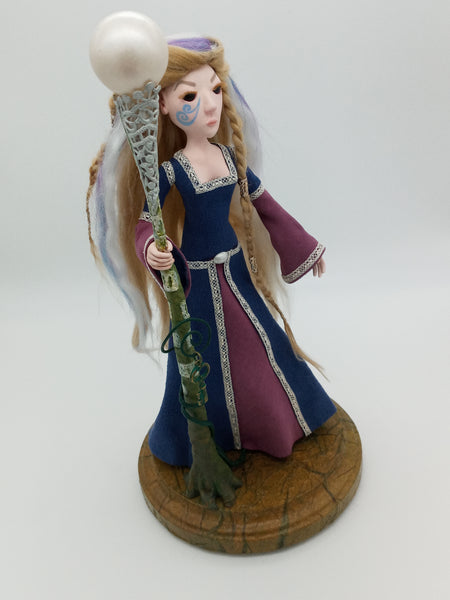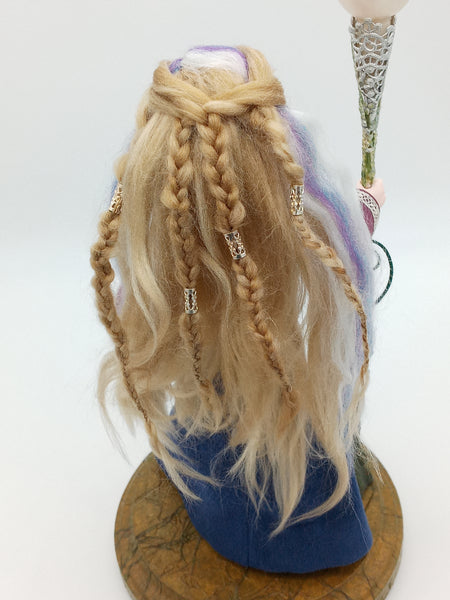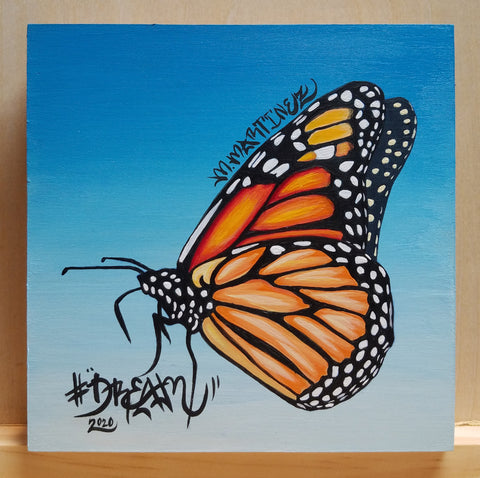Cactus Gallery LA
GWENHWYFAR by artist Jen Raven
Mixed-media/assemblage figurative sculpture, 9.5” x 4.75”
Figure stands 8.5” and is OOAK, no molds used. Wooden base with foam bottom 1” x 4.75”
Materials: Stone clay; acrylic yarns; found objects; Worbla thermoplastic; acrylic and oil paints; up-cylced fabrics and vintage trim. Colors: Royal blue, plum, green, gold, silver, pearl, lavender, cream, white, woad blue, tan, brown.
Staff 9” Requires two CR2032 batteries, please keep batteries away from pets and children, as they could be dangerous if swallowed. This is my first attempt at wiring battery operated lighting; Gwenhwyfar’s staff is idiosyncratic, lighting up when it pleases her, or not.
Long before she appeared as a Queen, in the Arthurian legends, Gwenhwyfar, Guinevere, Ginevra, or even Jennifer was revered by the Celts, as a Goddess. Her roles as assorted as the variations on her name, she has served as guardian of the passage between worlds, and guide of souls who travel from this world to the next. She has been Goddess of fertility and of the earth, with strong parallels to Persephone. She has been a Goddess of sovereignty and authority; even today, there are those who summon Her assistance, for answers and direction, especially in times of a need for leadership. I could not help but be struck by the significance of that, as I was creating this work in 2020.
Gwenhwyfar is also referred to as the ‘Virginal’ Goddess, though today we often mistake that meaning; ‘virginal’ in this case translates as “complete, in and of herself.” As a queen, Gwenhwyfar is the eternal feminine principle of strength and peace in the universe: She is powerful and influential without requiring a pairing or a partner --in other words, she doesn’t need a man. But he needs her: In the older stories, it was Gwenwhyfar who gave the legendary King of Camelot his right to rule, simply because they were together. Ancient Celtic tradition says that for a man to be King, he must be paired with the Goddess: Her role was to mix the King’s energy with the earth’s energy, in harmony. Arthur pursued her, then, not for love, but because without her he could not be King. In fact, in the Welsh Mabinogion called Culhwch and Olwen (circa 1100) she is listed among the weapons of another world, which Arthur received as a gift, suggesting her divine origin and reinforcing her power and sovereignty.
That’s a far cry from some of the more modern takes on Guinevere, depicted primarily in many of today’s stories as a secondary character --as the wife of a king-- or reduced to a plot device --as the love interest of a knight. Gwenhwyfar isn’t here to play scenery, or serve as anyone’s plot device, and she’s definitely not here to smile for you.





















